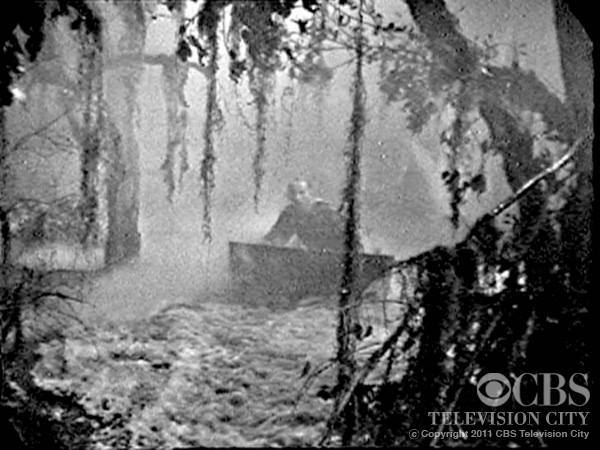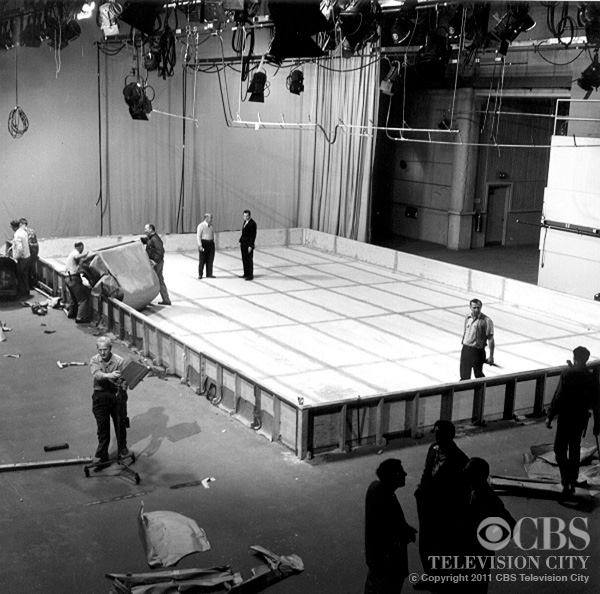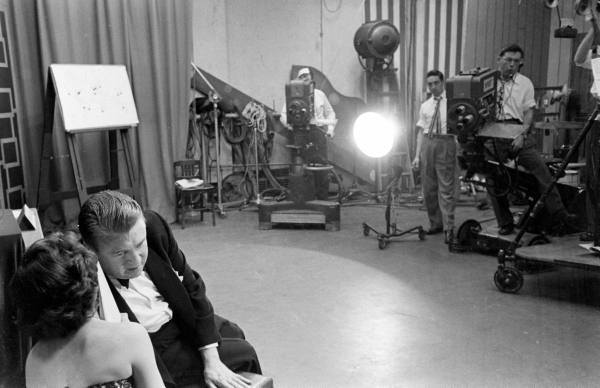- Home
- TV History
- Network Studios History
- Cameras
- Archives
- Viewseum
- About / Comments
Skip to content


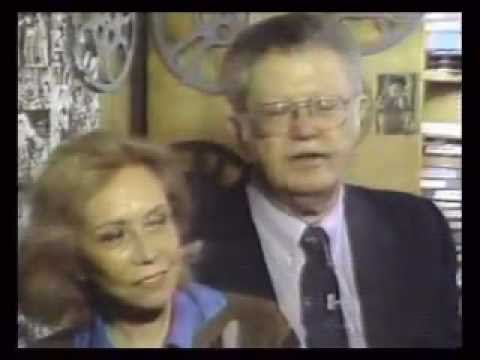

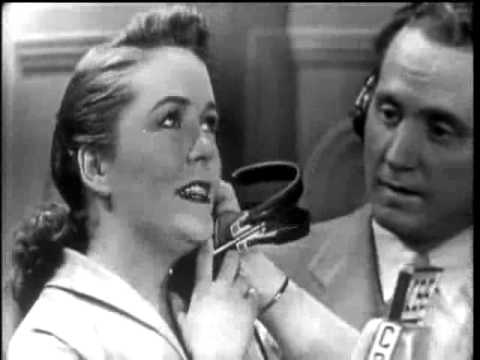






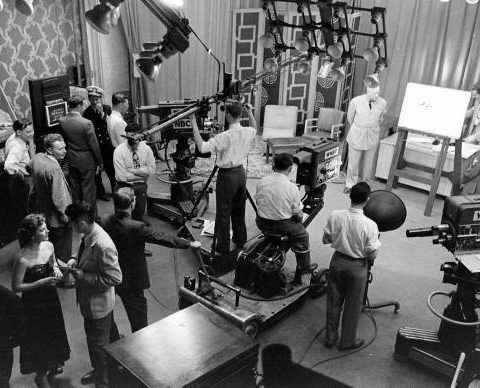
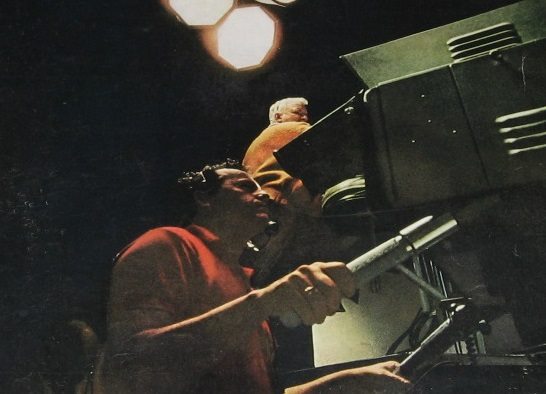
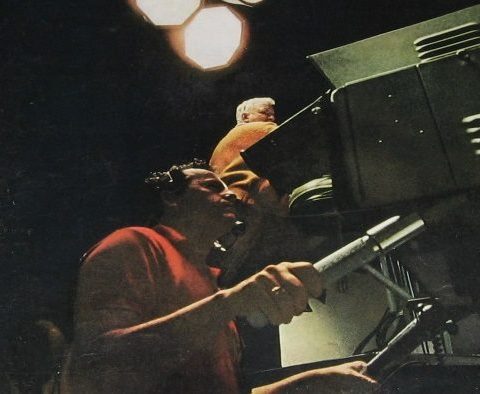
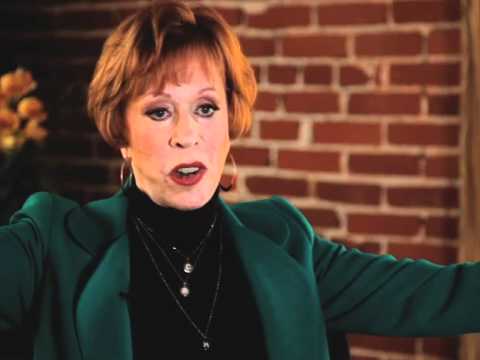
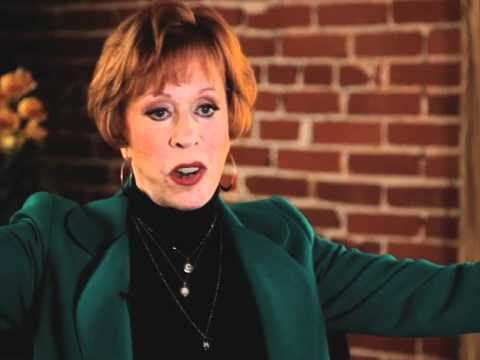

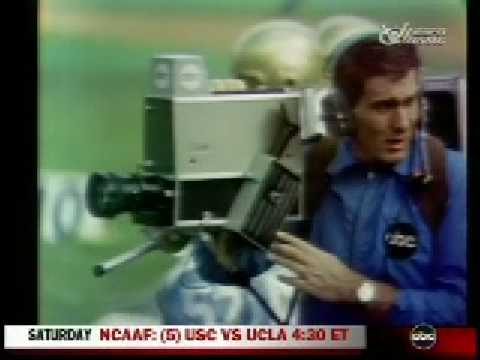
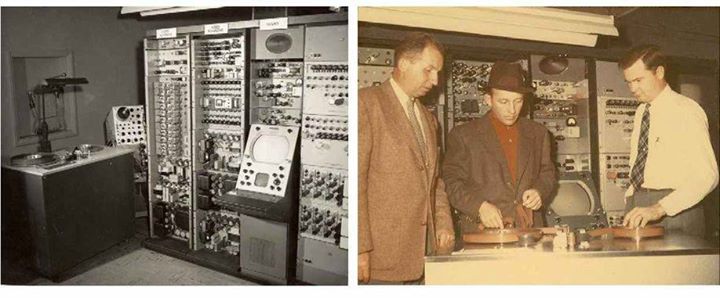
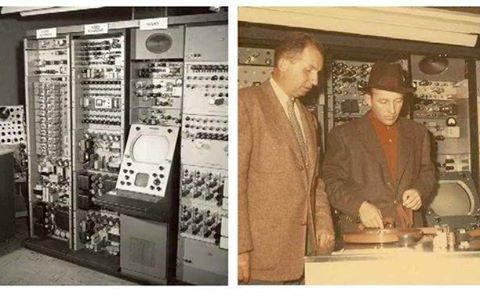



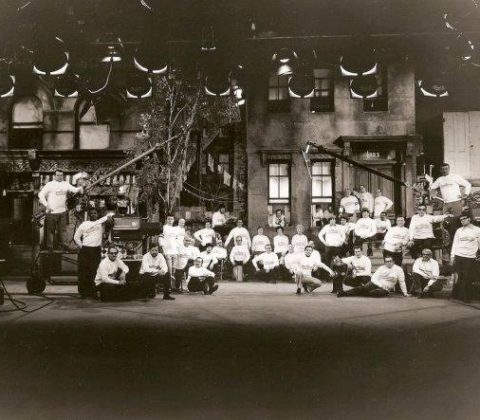


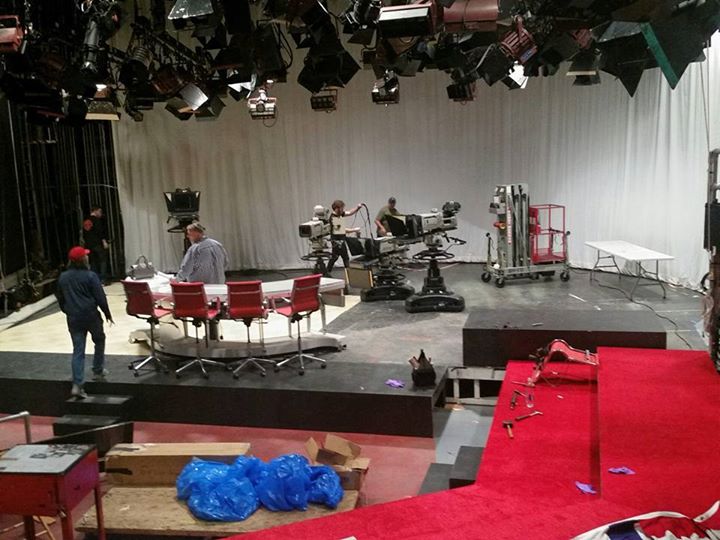
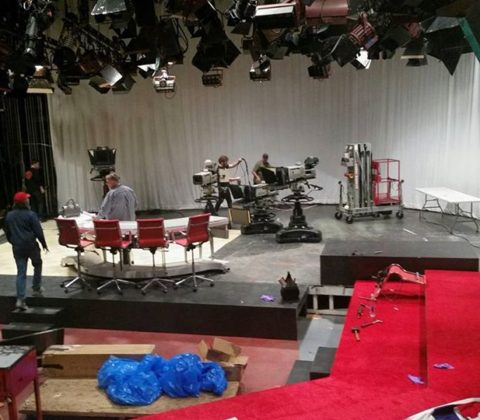
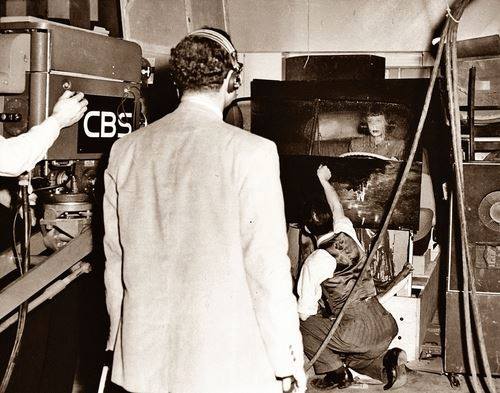

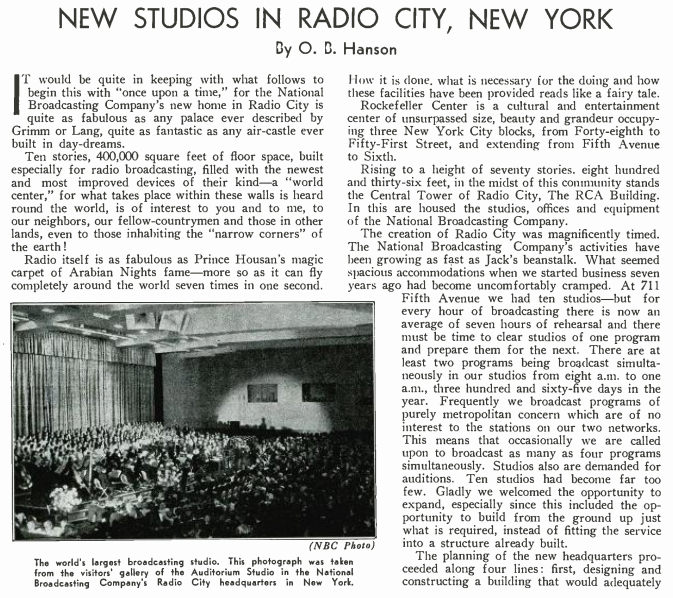
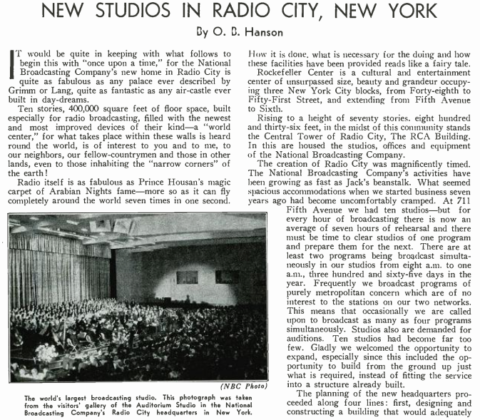
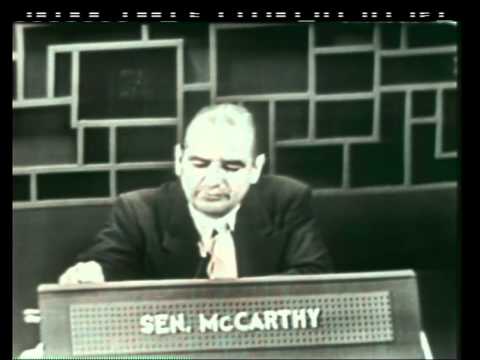

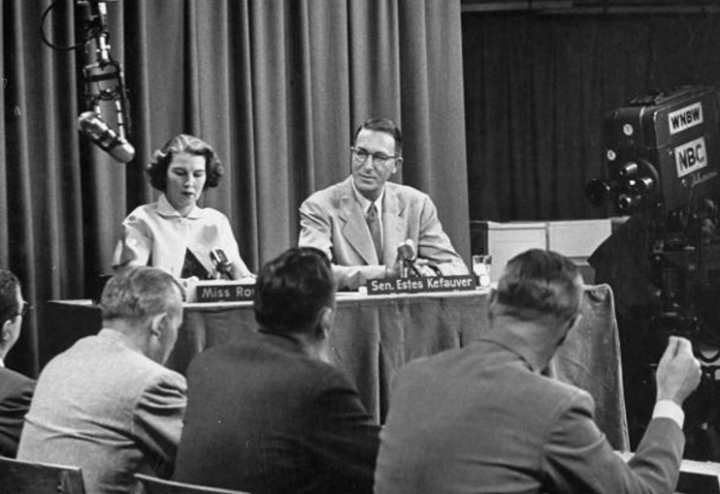
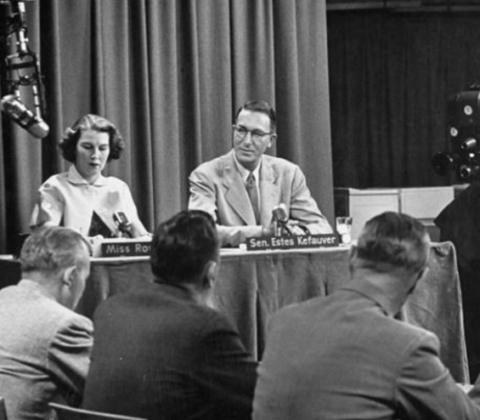
Posts in Category: TV History
Page 10 of 136
« Previous
1
2
3
4
5
6
7
8
9
10
11
12
13
14
15
16
17
18
19
20
21
22
23
24
25
26
27
28
29
30
31
32
33
34
35
36
37
38
39
40
41
42
43
44
45
46
47
48
49
50
51
52
53
54
55
56
57
58
59
60
61
62
63
64
65
66
67
68
69
70
71
72
73
74
75
76
77
78
79
80
81
82
83
84
85
86
87
88
89
90
91
92
93
94
95
96
97
98
99
100
101
102
103
104
105
106
107
108
109
110
111
112
113
114
115
116
117
118
119
120
121
122
123
124
125
126
127
128
129
130
131
132
133
134
135
136
Next » 
November 20, 1958…First Known Videotape Edited Show Airs
On November 20, 2016
- TV History
November 20, 1958…First Known Videotape Edited Show Airs
Seated on the right is director John Frankenheimer watching Ross Murray edit “Old Man”, which was a ‘Playhouse 90’ presentation that aired November 20, 1958.
This was the first time an entire production had ever been videotaped in advance and edited for air. The year before, Frankenheimer had used videotaped inserts in the live productions of two prior ‘Playhouse 90’ shows which were “Bomber’s Moon” and “The Days Of Wine And Roses”, but “Old Man” was a different ballgame.
Most of “Old Man” took place in a storm on the Mississippi River as an escaped convict fled from the law. The production used two studios at Television City (wet and dry) and was so daunting technically that the only way to do it was on tape. You can see some of the production shots below, including the huge Chapman movie crane they brought in.
On November 30, 1956 CBS had made history by tape delaying ‘Douglas Edwards With The News’ and again on October 13, 1957 when they used videotape to play back ‘The Edsel Show’ which aired live from Television City three hours earlier. -Bobby Ellerbee

November 19, 1959…America Meets Rocky And Bullwinkle
On November 19, 2016
- TV History
November 19, 1959…America Meets Rocky And Bullwinkle
Today is the anniversary of the debut of one of my all time favorite cartoon shows…probably one of yours too. The show debuted as ‘Rocky And His Friends’ on ABC and although done in color, it was broadcast in black and white. Before third season began in 1961, the show moved to NBC where it was broadcast in color and called ‘The Bullwinkle Show’.
Production began in February 1958 with the hiring of voice actors June Foray, Paul Frees, Bill Scott, and William Conrad. Ward hired most of the rest of the production staff, including writers and designers, BUT…no animators were hired!?! Why? Because Ward was able to convince some friends at Dancer, Fitzgerald, & Sample (an advertising agency that had General Mills as a client) to buy an animation studio in Mexico called Gamma Productions, originally known as Val-Mar Animation.
This outsourcing of the animation for the series was considered financially attractive by primary sponsor General Mills, but caused numerous problems. In a 1982 interview by animation historian Jim Korkis, Bill Scott described some of the problems that arose during production of the series: “We found out very quickly that we could not depend on Mexican studios to produce anything of quality. They were turning out the work very quickly and there were all kinds of mistakes and flaws and boo-boos. They would never check with us on details…mustaches popped on and off Boris, Bullwinkle’s antlers would change, colors would change and costumes would disappear. By the time we finally saw it, it was on the air.”
General Mills had signed a deal to sponsor the cartoon, under the condition that the show be run in a late-afternoon time slot, where it could be targeted toward children. The show was broadcast for the first time on November 19, 1959, on the ABC television network under the title ‘Rocky and His Friends’ twice a week, on Tuesday and Thursday afternoons, following American Bandstand at 5:30 p.m. ET, where it was the highest-rated daytime network program.
The show moved to the NBC network starting September 24, 1961, broadcast in color, and first appeared on Sundays at 7 p.m. ET, just before ‘Walt Disney’s Wonderful World of Color’. Bullwinkle’s ratings suffered as a result of being aired opposite perennial favorite Lassie. A potential move to CBS caused NBC to reschedule the show to late Sunday afternoons (5:30 p.m. ET) and early Saturday afternoons in its final season. NBC canceled the show in the summer of 1964. It was shopped to ABC, but they were not interested. However, reruns of episodes were aired on ABC’s Sunday morning schedule at 11 a.m. ET until 1973, at which time the series went into syndication.
An abbreviated fifteen-minute version of the series ran in syndication in the 1960s under the title ‘The Rocky Show’. This version was sometimes shown in conjunction with The King and Odie, a fifteen-minute version of Total Television’s King Leonardo and His Short Subjects. The King and Odie was similar to Rocky and Bullwinkle in that it was sponsored by General Mills and animated by Gamma Productions. NBC later aired Bullwinkle Show reruns at 12:30 p.m. ET Saturday afternoons during the 1981-1982 television season.
Below is a clip of the main voices of the show, June Foray and Bill Scott talking about their “adventures”. Other famous voices on the show included William Conrad as the narrator, Paul Frees as Boris Badenov, Wally Tetley as Sherman, Daws Butler as Aesop Junior and various other characters, Charlie Ruggles as Aesop, Hans Conried as Snidely Whiplash and Edward Everett Horton as the narrator for Fractured Fairy Tales. -Bobby Ellerbee

Les Paul & Mary Ford on “Omnibus” (1953)
On November 18, 2016
- TV History
FANTASTIC!…First TV Demonstration Of Multi Track Audio Tape Recording
In this 1953 kinescope from “Omnibus”, Alistair Cooke hosts Les Paul and Mary Ford in a recreation of their 1951 hit “How High The Moon”. The song not only topped the ‘Top 40’ charts, but the ‘R&B’ charts too, which was another first.
Although Les and Mary had released a few other multi tracked songs, which were well received, those were done with discs and not tape. Using the disc method was difficult and tedious, with one track at a time being added as the previous compilation of tracks was played back and re-recorded with each new part.
In 1947, Bing Crosby brought Les an Ampex 200 tape recorder to play with, and the rest is history. I am attaching two excellent links that go into great detail about the process and the string of discoveries, so make sure you take a look and a listen.
http://www.les-paul.com/timeline/sound-on-sound/
At the bottom of this page, there is an embedded video of Les recording “Brazil” on the discs, and when the pop up screen appears, click the play button at the bottom and the + and – controls to add or remove tracks.
http://www.soundonsound.com/people/classic-tracks-les-paul-mary-ford-how-high-moon
At this link, you’ll find a great history, most in Les’ own words, that take you from the start, all the way through the 8 track machines and more.
Finally, this clip came to my attention while watching the great PBS series “Soundbreaking” which has so far aired 4 of the 8 episodes (nightly) and I can’t wait for the rest.
By the way…notice in this video clip, the whole thing starts out with a prop given credit for the way the recording system works. That part is pure Les Paul. He was a joker and all around great guy. ENJOY and SHARE! -Bobby Ellerbee

Happy Birthday To Mickey Mouse…”Born” November 18, 1928
On November 18, 2016
- TV History
On November 18, 1928, ‘Steamboat Willie’, starring Mickey Mouse, was released and shown in theaters across the country. It was wildly popular.
This was the first cartoon with synchronized sound and was the first cartoon to feature a fully post-produced soundtrack which distinguished it from earlier sound cartoons.
Although animation filmmakers Dave and Max Fleischer’s Inkwell Studios had already produced seven sound cartoons, part of the Song Car-Tunes which started in May 1924, those failed to keep the sound fully synchronized. ‘Steamboat Willie’ was produced using a click track to help with musical cues.
The click track was sufficiently useful as a synchronization tool as optical marks were made on the film to indicate precise timings for musical accompaniment.
In 1994 professional animators voted Steamboat Willie 13th in the book “The 50 Greatest Cartoons”. By the way, Walt is the voice of Mickey in this historic cartoon, and although Mickey Mouse had been seen in theaters before this, his official birthday is marked as today in consideration of the success of ‘Steamboat Willie’. -Bobby Ellerbee
http://www.youtube.com/watch?v=BBgghnQF6E4
The classic Mickey Mouse cartoon

CBS News celebrates career of Bill Plante, retiring after 52 years
On November 17, 2016
- TV History
Happy Trails & Many Thanks To Bill Plante….
CBS News celebrates career of Bill Plante, retiring after 52 years
Plante covered many major stories of the past half century, from the Civil Rights Movement to the Vietnam War


November 17, 1946…TV’s 1st Magazine Style Show Debuts
On November 17, 2016
- Archives, TV History
November 17, 1946…TV’s 1st Magazine Style Show Debuts
“Television Screen Magazine” was the show, and it may have been the second ever NBC network series, but it was certainly among the first. NBC’s “Hour Glass” variety show came first with a debut on May 9, 1946. At the time, NBC’s television network included only three stations in New York, Schenectady and Philadelphia.
This weekly half hour program ran until July 23, 1949 and covered a lot of topics, but certain “sections” were recurring and were hosted by their “editors”. To reinforce the magazine format, magazine pages were turned before each new segment.
The lady in these photos (from 1948) is Ursula Halloran, who was a publicity agent for stars like Sid Caesar, Imogene Coca, Bob Hope and more.
Although it was not well known, Ursula and Bob had a very long affair, and once she finally gave up hope (literally), that Bob would leave his wife for her, the former beauty queen overdosed on sleeping pills.
The show ran on Sunday nights at 8:30 and the only other regular NBC network shows that year were, “Hour Glass”, “You Are An Artist” with John Gnagy (remember that?), and boxing shows that came from both Madison Square Garden and St. Nicholas Arena. -Bobby Ellerbee
NBC’s “Star Time Magazine”…1963-64 Guide To The New Season…
On November 13, 2016
- TV History
NBC’s “Star Time Magazine”…1963-64 Guide To The New Season
This is full of great memories, but make sure you take a look at the last pages, where you’ll see NBC’s new ‘Color Girl’ and a few of the first ever TK40 prototypes at The Colonial Theater.
In 1951, Marie McNamara became the first ‘Color Girl’ and when she left in ’63, Marilyn Gray took over. Thanks to Barry Mitchell for the link. -Bobby Ellerbee


November 13, 1976…Carol Burnett’s ‘Went With The Wind’ Sketch Debuts
On November 13, 2016
- TV History
November 13, 1976…Carol Burnett’s ‘Went With The Wind’ Sketch Debuted
https://www.youtube.com/watch?v=l0dqnZ2qyj4&ab_channel=TimeLife
One of the funniest and most memorable moments in American television came to us 40 yeas ago today.
In the clip below, Carol talks about the sketch and the dress. In another interview, I’ve heard her say that only she and Harvey Korman had seen the Bob Mackie dress. She had to let Havey in on the site gag, or he would break up to and not be able to do his lines to set her up for the big payoff line, “I saw it in the window and couldn’t resist”. Harvey actually makes for a pretty convincing Rhett Butler doesn’t he? Have a laugh, enjoy and share! -Bobby Ellerbee


November 11, 1967…ABC Debuts First Color Portable Camera …
On November 11, 2016
- TV History
November 11, 1967…ABC Debuts First Color Portable Camera
Below is a clip from November 11, 1967 showing the camera in use by ABC at the UCLA – USC game in Los Angeles.
ABC and Ampex worked together to come up with three configurations of the color portable unit. Shown here is the original cabled version, with a mini camera control unit in the back pack. Later, the back pack could be loaded with either an Ampex VR 3000 videotape recorder, or a microwave transmitter for live, uncabled work.
The Ampex, two Plumbicon, BC-100 camera head had an optical splitting system, providing one tube for the luminance channel and the other with an alternate red-blue image produced by a synchronously rotating filter wheel. Basically, this is a modified version of the Field Sequential color system.
The combination of luminance and green, with field sequential red and blue, is sent back to base via a compact microwave link mounted on the backpack. The base station uses a field-storage delay device to reinsert the alternately missed red and blue signals, providing Red, Green and Blue for matrixing and encoding into standard NTSC format. A nickel-cadmium battery keept the system operating for over an hour, with battery changes possible in a few minutes. -Bobby Ellerbee
November 11, 1951…First Video Image From Magnetic Tape
On November 11, 2016
- TV History
November 11, 1951…First Video Image From Magnetic Tape
Believe it or not, Bing Crosby Enterprises engineers Jack Mullen and Wayne Johnson were the first to produce an image from video tape.
What follows is a first hand account from BCE engineer Robert R. Phillips. Below that is a link to a much larger article on Crosby’s work in tape of all kinds. Enjoy and share! -Bobby Ellerbee
______________________________________________________________________________________________________
While there were many interesting experiences working at Bing Crosby Enterprises, none was as challenging as the development of a video recorder for Bing. When Jack told Bing in 1950 that it could be done, Bing responded by setting up the video recorder project to be led by Jack in the Electronic Division.
Mullin reached out and recruited Wayne Johnson to assist him, and by November 11, 1951 they demonstrated the first video picture from magnetic tape. It was a video of an airplane taking off. The image was very snowy and the airplane was a dark blob, but with the commentary by Frank Healey everyone managed to see the takeoff. Frank was an ex-movie producer.
I started with BCE about a week later later and found myself involved in the construction of what I call the Mark II version. The Mark I system used the top plate from one of the portable Ampex 200 audio tape recorders modified to operate at 360 ips (20 MPH) with a modified head that gave it a bandwidth of about 1 MHz. The tape was quarter-inch, and the reels did not have any sides to reduce once-a-round effects. This lack of sides produced large piles of tape if something went wrong. At times I had to go out the front door and down Sunset Blvd. with the tape to get it back on the reel. The drive was an early version of the tight loop.
The Mark II version used the same top plate as that of the Mark I, but it was modified for one inch tape. It still operated at 360 ips with the early version of the tight loop drive. Jack Mullin and Wayne Johnson had decided to build the Mark II system before the November 11 demonstration and were actively engaged in its construction. When I started at BCE they were testing various head stacks and working with William Wetzel at 3M to improve the tape quality for the recorder. It was obvious that main problem was how to increase the recorded bandwidth on the tape. We would find out over the next months that there was a lot that was not known about how the head-tape process works.
A discussion over using a rotary head approach to that of longitudinal had taken place, and there was much doubt that the rotary head would work. It also would have been difficult for the BCE group to implement it because of our lack of the mechanical facilities to build one. The longitudinal approach was selected with multiple tracks. Instead of using a rotary head, the multiple tracks were electronically scanned. The Mark II system had 12 tracks recorded on the 1 inch tape. Ten of the tracks were used for the video, and the other two, one on the top of the tape and one on the bottom, were used for audio, sync and reference signals.
The video signal in the record subsystem was sampled with the rate tied to the video sync signal. These samples or pulses were sequentially recorded across the 10 video tracks. For each set of 10 samples the polarity of the recorded pulse was reversed. This was done to prevent a bias on the tape. The result was a series of pulses recorded on each track on the tape alternating in polarity. The amplitude of the recorded pulse was equal to the amplitude of the video sample, and each channel had a 1 MHz bandwidth.
The playback system had to reverse the polarity of every other pulse and assemble them into a video stream of pulses combined with the video sync signal. The reference signals from the top and bottom tape channels were used to correct for tape speed and skew. This information was used to adjust the sampled video pulses from the tape. The video picture on the monitor consisted of a number analog “pixels” that had to be processed to eliminate the dot structure by averaging between them.
About a month after I started, Dean DeMoss and Chester Shaw were hired to help build and test the new electronics for the Mark II system. Gene Brown provided the mechanical support, and the system was built and operational by early 1952. Wayne Johnson and I were working on the system Friday night, 14 March 1952, and had completed the last adjustment to it. It was ready for its first recording test, and we decided to try it before we went home.
A video program was recorded and played back; it could have been classified as a fair picture. However, it did have the “pixels” since the additional processing had not been added. We jumped up and down and cheered. It turns out that we were the only two to see the picture because Wayne came in the next day and dismantled the recorder to “improve” it. Jack Mullin found out on Monday and was not happy that he missed the first successful test recording session.
During the 1952 and 1953 period the major effort was concentrated on improving the frequency response and reducing the tape speed. Many heads designs were tested using different types of magnetic materials, gap sizes and materials, and head windings. To make the heads, a precision optical lapping capability was installed along with a way of winding the coils on the assembled head segments. After trying many different head configurations, it was realized that there was a limitation in recording high frequencies on magnetic tape. A point was reached where changes in the head configuration and the tape speed made little difference in the upper frequency that could be recorded.
There were a number of other groups that were working on the video recorder. One of these was RCA, and its chairman General David Sarnoff wanted one for his birthday. By 1953 they had demonstrated a system that ran at 360 inches per second like the first BCE machine in 1951. It had better quality using video compression, but only lasted 4 minutes per reel.
The same year Sarnoff of RCA and his board of directors visited BCE to see if they could buy our recorder. The party arrived in a number of black limousines. Sarnoff was in the first dressed in gray and the board in the rest, dressed in black. As Sarnoff marched up the driveway the board fell in two-by-two behind him. They went into our small laboratory for the demonstration. Sarnoff sat in the middle and the board on either side of him.
After the demonstration they went upstairs to the conference room. Sarnoff told Frank Healey that he wanted to buy the recorder, and Frank told him it was not for sale. Sarnoff told Frank that he would just buy them out; to which Frank replied “You do not have enough money!” The RCA group left.
During this period the tight loop drive was perfected, and the correction of wow and flutter effects addressed. Much of this work also was used to improve the recording of the instrumentation telemetry. In the summer of 1953, I met Eugene Sakasegawa who was chief engineer of the USC television station. We were still looking for people who were good engineers with video experience, and I encouraged him to join us. He was hired, and his first assignment was to learn how to make magnetic heads. Gene was a craftsman and took up the challenge. After a couple of months of building new types of heads and not making any progress, Gene produced a head that broke the 1 MHz frequency barrier. Jack and Wayne could not believe it.
When asked what he did to make the head, he said that he made some small cuts inside the head to make it look better. He had been lapping the head halves to create a uniform gap and also the head face. These actions did make a small difference in the performance, but the “beauty treatment” was the key. The head laminations at the head gap were different widths and caused a non-uniform magnetic pattern across the tape (top to bottom). Gene had made a very accurate cut behind the head gap across the laminations. This cut made them the same thickness and caused the magnetic pattern across the tape to be uniform.
A number of different cuts were tested until proper configuration was found. The result of the head “beauty treatment” was to reduced the tape speed of the Mark II to 120 ips and produce a new design for the recording the video information. The new “Mark III” recorder operated at 100 ips with half-inch tape using longitudinal recording and no scanning. It recorded color video and sound with three heads – video, color, and sound/reference. The recorder also employed video compression techniques, and an early version was demonstrated in February 1955.
The recorder was further refined and demonstrated in June 1955. Based on the performance of this new recorder CBS ordered three of them, and the summer of that year we worked building them. In late 1955 Bing asked Jack Mullin to visit Ampex to see their video tape recorder. We knew that they were working on one, but did not know how far they had come.
Jack went to Ampex near the end of the year and came back with the news that it was over, Ampex had a better recorder. Bing sent another $50,000 check to Ampex for the first of their video recorders. It was delivered to his TV station in Washington State. Ampex demonstrated their rotary head machine on 14 April 1956; CBS cancelled their order with BCE and bought the Ampex recorder. The Mark III recorders were then converted to wide band instrumentation recorders and sold.
For MUCH MORE, follow this link.
http://ethw.org/First-Hand:Bing_Crosby_and_the_Recording_Revolution
Welcome To The Heart Of Eyes Of A Generation!
On November 10, 2016
- TV History

This 100+ pages of television history is unique in all the world! This is a living history of broadcasting that spans the decades, as far back as the first radio transmissions, to the latest in the network studios and everything in between. These are stories that I have written and posted on the Eyes Of A Generation Facebook page, that go back to 2011. There are video tours of historic TV landmarks, stories on rescued cameras and VTRs, funny odds and ends and a hundred surprises that come in every shape form and fashion.
One of the most important elements of all of this, is the comments that were made when these stories were written and posted on Facebook. The comments came from industry veterans…the people that were there at the time, either directing, or on camera, in lighting, writing, producing or whatever and those have been wrapped into the original stories that you see here. To see the original comments and stories on Facebook (and if you are a FB user), just right click on the story title, open it in another tab, and click the green SOURCE text at the bottom left of the post to see the original…sometime with more details and photos. Enjoy! -Bobby Ellerbee


November 10, 1938…First Ever Performance, “God Bless America”
On November 10, 2016
- TV History
November 10, 1938…First Ever Performance, “God Bless America”
Tomorrow is Veterans Day in America, a tribute day that was originally called Armistice Day. It is still observed in many countries by it’s original name, and as Remembrance Day, which marked the end of World War I on November 11, 1918.
From one veteran to all the others past, present and future…Thank You for your service!
Irving Berlin had originally written the song in 1918 while serving in the U.S. Army at Camp Upton in Yaphank, New York, but decided that it did not fit in a USO type revue called ‘Yip Yip Yaphank’, so he set it aside.
In 1938, with the rise of Hitler, Berlin, who was Jewish, and a first-generation European immigrant, felt it was time to revive it as a “peace song”, and it was introduced on the Armistice Eve broadcast of ‘The Kate Smith Hour’ November 10, 1938. Kate Smith was the fist to sing it and this is a recording of that first ever public performance as broadcast on her CBS Radio show.
Turn it up and listen. If you are like me, you may have to wipe a tear from your eye afterward. Enjoy and Share! -Bobby Ellerbee
https://www.youtube.com/watch?v=b1rKQReqJZg
“This is the original FIRST broadcast radio performance of God Bless America by Irving Berlin as introduced by Kate Smith on November 10, 1938. She later rec…
Source
November 10, 1969…”Sesame Street” Debuts On PBS
On November 10, 2016
- TV History
November 10, 1969…”Sesame Street” Debuts On PBS
Here is the full debut episode of the show.
Since almost almost everyone in the world knows the show, since it’s now on in 123 countries, we’ll celebrate the anniversary with a look at the early production history.
In the photos below, we see the original home of the show which was done from the old RKO 81st Street Theater at 2248 Broadway. The theater was owned by Teletape Productions, but before this, it had been the home of the first and only CBS color studio on the east coast…Studio 72 which was created in the fall of 1954.
Also shown here is an early cast and crew photo with the Marconi Mark VII color cameras. The color photo of a Mark VII shooting Grover is the one that I now have in my collection…it was Camera 2 and in the closeup, you can see that the dome tally light number is the same. There were six Mark VIIs in use on the show.
Teletape was a video production company that merged with Reeves Sound Services in 1974 and became Reeves Teletape. Before that, Reeves had been more of a sound and video post edit company.
According to our friend Dennis Degan, who worked at Reeves Teletape, R/T moved ‘Sesame Street’ production in 1983 from 81st Street to the 55th Street studio, which was formerly WNET-TV’s studio on 9th Ave at 55th Street. They made this move because R/T sold the 81st Street studio. They originally bought it from CBS in 1967.
Sesame Street was produced at 55th Street from 1983 to around 1990, first with R/T, then in 1987 with Unitel Video, as R/T went out of business. Sesame moved to Kaufman-Astoria Studios in 1990 where it has remains to this day. The RKO 81 studio was torn down in 1986. This little history lesson was brought to you by the letter B for Bobby. Enjoy and share! -Bobby Ellerbee
November 8, 1952…NBC’s First Full Color Facility Debuts
On November 8, 2016
- Archives, TV History
On this day in 1952, The Colonial Theater broadcast it’s first color production to the network. Fittingly, the show was NBC’s top rated Saturday night program, “Your Show Of Shows”, but it was a one time event. At least for “YSOS”, as it was NBC’s intent to rotate all of their New York based shows trough the Colonial for a color show for two reasons.
The first reason was to help teach the producers and talent how to do color shows, and the second reason was to continue to demonstrate that the RCA Dot Sequential color system really was “compatible color”…that is, received by black and white sets, just as well as regular black and white broadcasts.
I think The Colonial first came to the attention of RCA/NBC in October of 1951 when RCA exhibited a color TV receiver-projector there, which provided color pictures on a 9 x 12 foot theater screen.
At this time, the 1,300 seat theater built in 1905, was in an RKO movie theater. In 1935, RKO converted it from a vaudeville and live theater venue to a movie theater, but newer theaters nearby had taken the wind from The Colonial’s sails.
The Colonial was located at 1887 Broadway and became NBC’s 15th studio with a November 8, 1952 debut. Gone, but not forgotten! -Bobby Ellerbee
Election Day In Television Land…Special Coverage Sets
On November 8, 2016
- TV History
Election Day In Television Land…Special Coverage Sets
In these photos from friends prepping now in New York, here is a look at some of the sets that will be used today, starting with MSNBC’s “Morning Joe” set being built in Studio 8H for a special live audience show tomorrow. There is more on each photo, so click through. AND, in the comments section below, there is a video from Ethan Harp at The Javits Center showing the layout of the facility and stage for the Hillary Clinton event tonight. Thanks to all our friends for the pix, and for all your long hours today! Oh, and please share your electoion day pix below! -Bobby Ellerbee
November 7, 1948…”Studio One” Debuts On CBS
On November 7, 2016
- TV History
November 7, 1948…”Studio One” Debuts On CBS
The first episode, brought with it another first…one of TV’s first live special effects shots. In the photo, we see star, Margaret Sullivan, “driving in the rain” on the first telecast. That first presentation was titled “The Storm” and originated from Studios 41 and 42 at Grand Central. It was produced by Worthington Minor, and directed by Yul Brynner. In the other photo, we see Sullivan with co-star Dean Jagger on the set.
“Studio One” was one of the most significant U.S. anthology drama series during the 1950s. Like other anthology series of the time… “Robert Montgomery Presents”, “Goodyear Television Playhouse”, “Philco Theater”, “Kraft Television Theater”, and others, the format was organised around the weekly presentation of a one hour, live, television play. Several hours of live drama were provided by the networks per week, each play different: such risk and diversity is hard to come by today.
Offering a wide range of dramas, “Studio One” received Emmy nominations every year from 1950 to 1958, and staged many notable and memorable teleplays among its 467 episodes from 1948 till 1958.
Some created such an impact they were adapted into theatrical films. William Templeton’s 1953 adaptation of George Orwell’s novel “Nineteen Eighty-Four”, starring Eddie Albert as Winston Smith, led to the 1956 feature film version with Edmond O’Brien in the principal role.
Reginald Rose’s drama “Twelve Angry Men”, about the conflicts of jurors deciding a murder case, originated on Studio One on September 20,1954 and the 1957 motion picture remake with Henry Fonda was nominated for three Academy Awards. -Bobby Ellerbee
November 7, 1933…RCA/NBC Dedicates 30 Rockefeller Plaza
On November 7, 2016
- TV History
November 7, 1933…RCA/NBC Dedicates 30 Rockefeller Plaza Bldg.
On November 7, 1933 NBC held dedication ceremonies and special programs at its new 30 Rockefeller Plaza head quarters at Radio City. Thus began a five day, round the clock, parade of movers from their 711 Fifth Avenue home to their new one at Radio City.
There were 27 new state of the art studios in service, with more yet to come which would occupy two entire floors (6&7), which were left unfinished till November of 1941, when radio studios 6A and 6B were completed.
What we know as Studio 8H was referred to as the “Auditorium Studio” and 8G was called “The Radio Guild Studio”. The first broadcast was at 8PM Saturday night, Nov 11. The inaugurating sound was that of the national anthem performed by the NBC Symphony Orchestra conducted by Frank Black from Studio 8H with 1,200 special guest.
This is the story from the December 1933 issue of “Radio Engineering Magazine”. Happy Birthday 30 Rock! -Bobby Ellerbee


November 7, 1954…”Face The Nation” Debuts On CBS
On November 7, 2016
- TV History
November 7, 1954…”Face The Nation” Debuts On CBS
Wait till you see this video of the first ever presentation of “Face The Nation”! The first thing you see is a closeup of a camera’s lens turret, in a widening shot, that would be the standard open for several years. The “guest” camera is behind the set wall, shooting over the shoulders of the panel.
On that Sunday, November 7, 1954. That first ‘Face The Nation’ guest was Sen. Joe McCarthy. In the early days, the show was broadcast on Sunday afternoons at 2:30 eastern. The program’s original host was Tedd Koop, then the Washington D.C. bureau chief for CBS News and originated from the network owned WTOP in Washington.
The show as created by the late Frank Stanton, who ran the network for over 20 years. When asked why he started it, he said simply, “Because NBC had ‘Meet the Press,’ and I thought we needed a program like that.”
We miss Bob Scheiffer, but his replacement, John Dickerson is quite good and it feels like he’s been there for years. Enjoy and share! -Bobby Ellerbee
https://www.youtube.com/watch?v=FtVJFBSMXDk
In the first Face the Nation broadcast on television, Sen. Joseph McCarthy responds to questions about his infamous hearings. (CBS NEWS)
Source
November 6, 1947…’Meet The Press’ Debuts, NBC
On November 6, 2016
- TV History
November 6, 1947…’Meet The Press’ Debuts, NBC
This is America’s longest running television program. Almost everyone thinks of it as a Sunday morning show, but when it started, it was a Saturday night show, and hosted by a woman.
Her name was Martha Rountree and she started as a reporter at The Tampa Tribune, but she wasn’t reporting on social occasions or homemaking. As a kind of rebel from the start, her duties included writing a sports column under the name “M. J. Rountree,” with Tribune readers none the wiser as to the sex of the journalist who was, after all, writing in a field dominated by men.
A local CBS station was impressed enough by her work that they gave her a chance to write for radio, at which she excelled. From there, she headed north to New York, where she wrote ad copy, but Rountree was not comfortable playing so minor a part of an industry she felt held greater opportunities for her.
“I got the ideas, worked them out; other people got the credit,” she lamented. “I wanted to produce myself. To prove that she meant business, she and her sister Ann, opened a production firm called Radio House, which prepared transcribed programs and singing commercials.
1945 was Rountree’s banner year. She made her mark on radio in a big way, selling the idea for two different panel shows to the Mutual Radio Network, premiering them a day apart in October. One was ‘Leave It to the Girls’, the other was ‘Meet The Press’ which debuted first on October 5, 1945.
Although frequently credited as a co-creation of Rountree and Lawrence E. Spivak, publisher and editor of American Mercury magazine, authoritative sources adamantly state that it was Rountree who developed the premise on her own, with Spivak joining up as co producer and business partner in the enterprise after the show had already debuted.
Our friend Max Schindler, who directed the show for over 20 years, had this to say about the creator credit, “Whoever conceived it, it was Spivak who made it a success…he dedicated his life to it”.
Here is more from Max, on directing the show. https://interviews.televisionacademy.com/shows/meet-the-press?clip=15097#highlights
On November 6, 1947, while still on Mutual Radio, the show came to NBC Television. ‘Meet the Press’ was originally presented on Saturday night at 7:30 as a half hour show with a single guest and a panel of questioners. The first guest was James Farley, who served as Postmaster General, Democratic National Committee chairman and campaign manager to Franklin Delano Roosevelt under the first two terms of the New Deal Administration.
The first host was its creator, Martha Rountree, the program’s only full time female moderator to date. She stepped down on November 1, 1953 and until Ned Brooks could take over, her friend Deena Clark filled in.
Rountree was succeeded by Ned Brooks, who remained as moderator until his retirement on December 26, 1965. Although Spivak became the moderator on January 1, 1966, he did not really want the job. Max Schindler said, “Spivak didn’t want to moderate…he wanted Edwin Neuman, but NBC could not spare him, so he reluctantly took over”. He retired on November 9, 1975, on a special one-hour edition that featured, for the first time, a sitting president, Gerald Ford, as the guest.
The next week, Bill Monroe, previously a weekly panelist like Spivak took over as moderator and stayed until June 2, 1984. For the next seven and a half years, the program then went through a series of hosts as it struggled in the ratings against ABC’s ‘This Week with David Brinkley’. Roger Mudd and Marvin Kalb (as co-moderators) followed Monroe for a year, followed by Chris Wallace from 1987 to 1988. Garrick Utley hosted ‘Meet the Press’ from 1989 through December 1, 1991 at which time Tim Russert took over, and not long after that, the show went to a one hour format.
Russert’s untimely death gave David Gregory the seat, and now Chuck Todd is host.
Rountree died on August 23, 1999, in Washington, where she had made her name as one of the key figures in political reporting. Tim Russert, summed up her status in the medium by declaring, “She was a news pioneer who helped create a national treasure, Meet the Press.” Enjoy and share! -Bobby Ellerbee
Page 10 of 136
« Previous
1
2
3
4
5
6
7
8
9
10
11
12
13
14
15
16
17
18
19
20
21
22
23
24
25
26
27
28
29
30
31
32
33
34
35
36
37
38
39
40
41
42
43
44
45
46
47
48
49
50
51
52
53
54
55
56
57
58
59
60
61
62
63
64
65
66
67
68
69
70
71
72
73
74
75
76
77
78
79
80
81
82
83
84
85
86
87
88
89
90
91
92
93
94
95
96
97
98
99
100
101
102
103
104
105
106
107
108
109
110
111
112
113
114
115
116
117
118
119
120
121
122
123
124
125
126
127
128
129
130
131
132
133
134
135
136
Next » 
